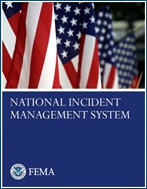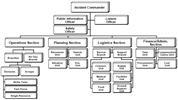NIMS & ICS
National Incident Management System and the Incident Command System
Both National Incident Management System (NIMS) and the National Response Framework (NRF) are incorporated into virtually every course offered by AHT. The numerous command and control courses, for example, support provisions of the National Incident Management System (NIMS) and Incident Command System (ICS). We offer courses in preparedness planning, training and management as well as instructor-led field and hands-on courses that addresses key elements of NIMS within an all-hazard environment.
The National Incident Management System (NIMS) provides a systematic,proactive approach to guide departments and agencies at all levels of government, nongovernmental organizations, and
 the private sector to work seamlessly to prevent, protect against, respond to, recover from, and mitigate the effects of incidents, regardless of cause, size, location, or complexity, in order to reduce the loss of life and property and harm to the environment.
the private sector to work seamlessly to prevent, protect against, respond to, recover from, and mitigate the effects of incidents, regardless of cause, size, location, or complexity, in order to reduce the loss of life and property and harm to the environment.
NIMS works hand in hand with the National Response Framework (NRF). NIMS provides th
e template for the management of incidents, while the NRF provides the structure and mechanisms for national-level policy for incident management.
One of the most important 'best practices' that has been incorporated into the NIMS is the Incident Command System (ICS), a standard, on-scene, all-hazards incident management system already in use by firefighters, hazardous materials teams, rescuers and emergency medical teams. The ICS has been establis
hed by the NIMS as the standardized incident organizational structure for the management of all incidents.
NIMS is not an operational incident management or resource allocation plan. NIMS represents a core set of doctrines, concepts, principles, terminology, and organizational processes that enables effective, efficient, and collaborative incident management.
Building on the foundation provided by existing emergency management and incident response systems used by jurisdictions, organizations, and functional disciplines at all levels, NIMS integrates best practices into a comprehensive framework for use nationwide by emergency management/response personnel in an all-hazards context. These best practices lay the groundwork for the components of NIMS and provide the mechanisms for the further development and refinement of supporting national standards, guidelines, protocols, systems, and technologies. NIMS fosters the development of specialized technologies that facilitate emergency management and incident response activities, and allows for the adoption of new approaches that will enable continuous refinement of the system over time.
The Incident Command System (ICS) is used for a broad spectrum of incidents, from routine to complex, both naturally occurring and manmade, by all levels of government-Federal, State, tribal, and local-as well as nongovernmental organizations (NGOs) and the private sector. It is the combination of facilities, equipment, personnel, procedures, and communications operating within a common organizational structure, designed to aid in incident management activities.
Some of the more important "transitional steps" that are necessary to apply ICS in the incident scene environment include the following:
- Recognizing and anticipating the requirement that organizational elements be activated and taking the necessary steps to delegate authority, as appropriate.
- Establishing incident facilities as needed, located to support field operations.
- Establishing the use of common terminology for organizational elements, position titles, facilities, and resources.
- Rapidly evolving from oral direction to the development of a written Incident Action Plan (IAP).
FUNCTIONAL STRUCTURE
The Incident Command System comprises five major functional areas: Command, Operations, Planning, Logistics, and Finance/Administration. (A sixth functional area, Intelligence/Investigations, may be established if required.)
MODULAR EXPANSION
The ICS organizational structure is modular, extending to incorporate all elements necessary for the type, size, scope, and complexity of an incident. It builds from the top down; responsibility and performance begin with Incident Command. When the need arises, four separate Sections can be used to organize the General Staff. Each of these Sections may have several subordinate units, or Branches, depending on the incident's management requirements. If one individual can simultaneously manage all major functional areas, no further organization is required. If one or more of the functions requires independent management, an individual is assigned responsibility for that function.
As a system, ICS is extremely useful; not only does it provide an organizational structure for incident management, but it also guides the process for planning, building, and adapting that structure. Using ICS for every incident or planned event helps hone and maintain skills needed for the large-scale incidents.


